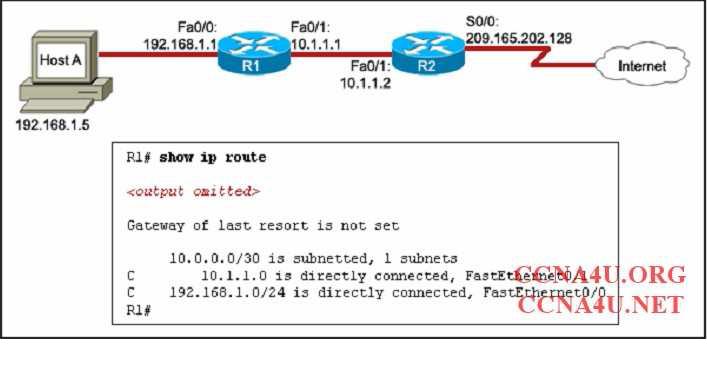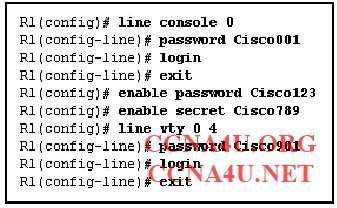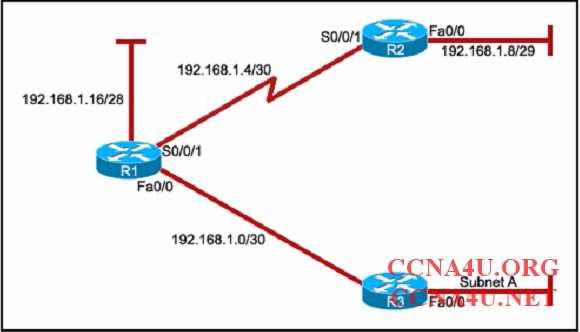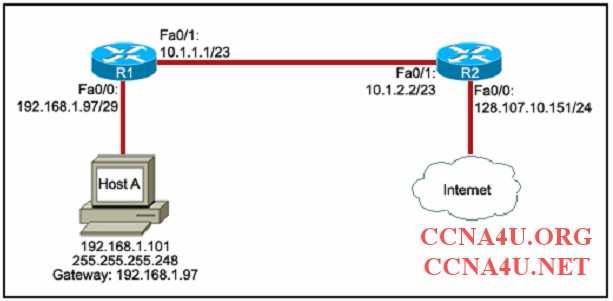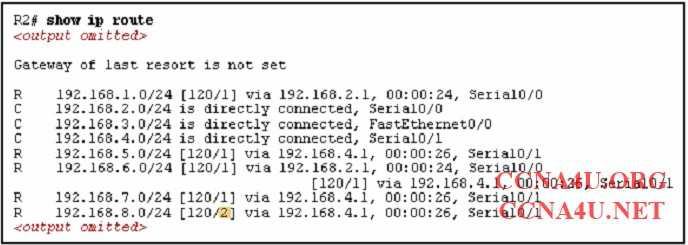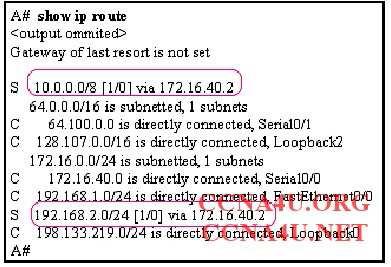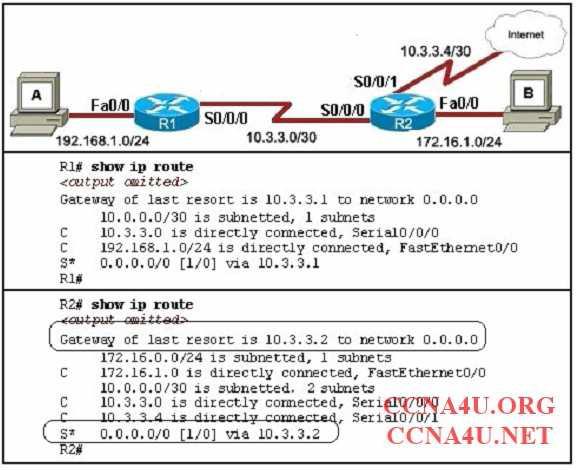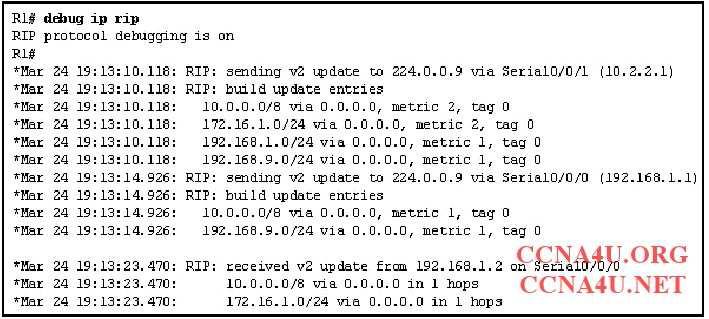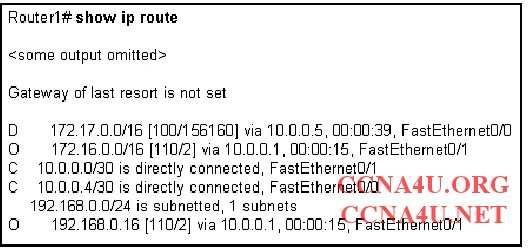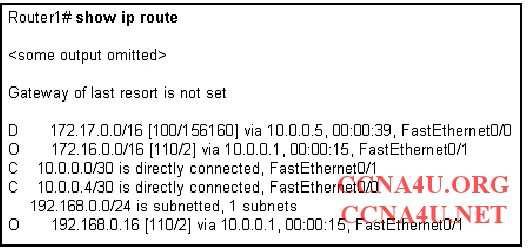Enhance Your Knowledge On Ccna2 Final E
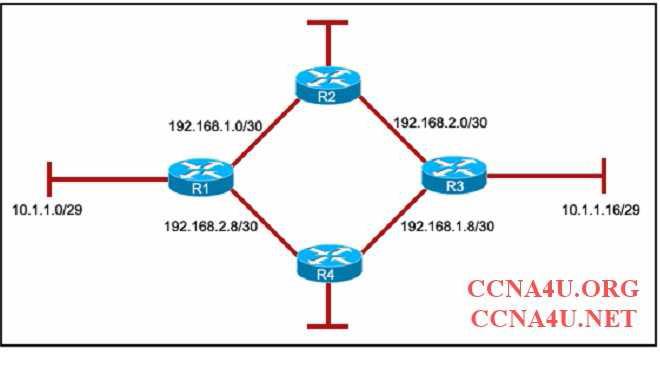
Your studies on the Cisco Certified Network Associate have led you to this moment – the finals are coming up, and this quiz aims to enhance your knowledge on everything you need to know in order to achieve your certification and hopefully get a good job in the field of networking.
- 1.
Which routing protocol maintains a topology table separate from the routing table?
- A.
IGRP
- B.
RIPv1
- C.
RIPv2
- D.
EIGRP
Correct Answer
D. EIGRPExplanation
EIGRP (Enhanced Interior Gateway Routing Protocol) maintains a topology table separate from the routing table. This allows EIGRP to have a more detailed view of the network topology, including information about all available routes, their metrics, and their status. By keeping this information in a separate table, EIGRP can make more efficient and informed routing decisions, resulting in better network performance and faster convergence.Rate this question:
-
- 2.
Refer to the exhibit. All routers are running RIPv1. The two networks 10.1.1.0/29 and 10.1.1.16/29 areunable to access eachother. What can be the cause of this problem?
- A.
Because RIPv1 is a classless protocol, it does not support this access.
- B.
RIPv1 does not support discontiguous networks.
- C.
RIPv1 does not support load balancing.
- D.
RIPv1 does not support automatic summarization.
Correct Answer
B. RIPv1 does not support discontiguous networks.Explanation
The cause of the problem could be that RIPv1 does not support discontiguous networks. This means that RIPv1 cannot handle networks that are not directly connected or have non-contiguous subnet masks. As a result, the two networks 10.1.1.0/29 and 10.1.1.16/29 are unable to communicate with each other because RIPv1 cannot properly route the traffic between them.Rate this question:
-
- 3.
Which two statements are correct about the split horizon with poison reverse method of routing loop prevention? (Choose two.)
- A.
It is enabled by default on all Cisco IOS implementations.
- B.
It assigns a value that represents an infinite metric to the poisoned route.
- C.
It sends back the poisoned route update to the same interface from where it was received.
- D.
It instructs routers to hold all changes that might affect routes, for a specified period of time.
- E.
It limits the number of hops a packet can traverse through the network before it is discarded.
Correct Answer(s)
B. It assigns a value that represents an infinite metric to the poisoned route.
E. It limits the number of hops a packet can traverse through the network before it is discarded.Explanation
The split horizon with poison reverse method of routing loop prevention assigns a value that represents an infinite metric to the poisoned route. This ensures that the poisoned route is considered unreachable and not used for forwarding packets. Additionally, this method limits the number of hops a packet can traverse through the network before it is discarded. By discarding packets that exceed the hop limit, the method prevents routing loops and improves network efficiency.Rate this question:
-
- 4.
What are two reasons for the occurrence of a routing loop? (Choose two.)
- A.
Slow convergence
- B.
Incorrectly configured static routes
- C.
Routes that are learned via two routing
- D.
Static and dynamic routing being used on the same router
- E.
Lack of a default route on the router that connects to the Internet
Correct Answer(s)
B. Incorrectly configured static routes
D. Static and dynamic routing being used on the same routerExplanation
Routing loops can occur for two reasons: incorrectly configured static routes and static and dynamic routing being used on the same router. Incorrectly configured static routes can lead to loops when the routes are pointing to each other or when there are overlapping routes. When static and dynamic routing protocols are used on the same router, there is a possibility of conflicting information being received, leading to loops. Slow convergence, routes learned via two routing protocols, and lack of a default route on the router that connects to the Internet are not directly related to the occurrence of routing loops.Rate this question:
-
- 5.
All routers in a network are configured in a single OSPF area with the same priority value. No loopback interface has been set on any of the routers. Which secondary value will the routers use to determine the router ID?
- A.
The highest MAC address among the active interfaces of the network will be used.
- B.
There will be no router ID until a loopback interface is configured.
- C.
The highest IP address among the active FastEthernet interfaces that are running OSPF will be used.
- D.
The highest IP address among the active interfaces will be used.
Correct Answer
D. The highest IP address among the active interfaces will be used.Explanation
The routers in the network will use the highest IP address among the active interfaces to determine the router ID. The router ID is a unique identifier for each router in OSPF, and it is used for various purposes such as the selection of the designated router and the calculation of the shortest path tree. In this case, since no loopback interface has been set on any of the routers, the highest IP address among the active interfaces will be used as the router ID.Rate this question:
-
- 6.
Refer to the exhibit. Although R2 is configured correctly, host A is unable to access the Internet. Whatare two staticroutes that can be configured on R1, either of which would enable Internet connectivity for host A?(Choose two.)
- A.
Ip route 0.0.0.0 0.0.0.0 Fa0/0
- B.
Ip route 0.0.0.0 0.0.0.0 Fa0/1
- C.
Ip route 0.0.0.0 0.0.0.0 10.1.1.1
- D.
Ip route 0.0.0.0 0.0.0.0 10.1.1.2
- E.
Ip route 209.165.202.0 255.255.255.0 10.1.1.1
Correct Answer(s)
B. Ip route 0.0.0.0 0.0.0.0 Fa0/1
D. Ip route 0.0.0.0 0.0.0.0 10.1.1.2Explanation
Two static routes that can be configured on R1 to enable Internet connectivity for host A are "ip route 0.0.0.0 0.0.0.0 Fa0/1" and "ip route 0.0.0.0 0.0.0.0 10.1.1.2". The first route specifies that any traffic with a destination IP address of 0.0.0.0 should be forwarded out of the Fa0/1 interface. The second route specifies that any traffic with a destination IP address of 0.0.0.0 should be forwarded to the next hop IP address 10.1.1.2. These routes will allow host A to reach the Internet.Rate this question:
-
- 7.
What is the function of the OSPF LSR packet?
- A.
It is used to confirm the receipt of LSUs.
- B.
It is used to establish and maintain adjacency with other OSPF routers.
- C.
It is used by the receiving routers to request more information about any entry in the DBD.
- D.
It is used to check the database synchronization between routers
Correct Answer
C. It is used by the receiving routers to request more information about any entry in the DBD.Explanation
The OSPF LSR (Link State Request) packet is used by receiving routers to request more information about any entry in the DBD (Database Description). This packet is sent when a router needs more detailed information about a particular entry in the database. By requesting additional information, the router can ensure that it has the most up-to-date and accurate data for making routing decisions.Rate this question:
-
- 8.
Refer to the exhibit. A network administrator is accessing router R1 from the console port. Once the administrator is connected to the router, which password should the administrator enter at the R1> prompt to access the privileged EXECmode?
- A.
Cisco001
- B.
Cisco123
- C.
Cisco789
- D.
Cisco901
Correct Answer
C. Cisco789Explanation
The correct password that the administrator should enter at the R1> prompt to access the privileged EXEC mode is "Cisco789".Rate this question:
-
- 9.
Which two technologies can be used in distance vector routing protocols to prevent routing loops?(Choose two.)
- A.
Authentication
- B.
Link-state advertisements
- C.
Hold-down timers
- D.
Spanning Tree Protocol
- E.
Split horizon
Correct Answer(s)
C. Hold-down timers
E. Split horizonExplanation
Hold-down timers and split horizon are two technologies that can be used in distance vector routing protocols to prevent routing loops. Hold-down timers are used to temporarily ignore route updates after a route has been invalidated, preventing the router from immediately accepting a potentially incorrect route. Split horizon is a technique where a router does not advertise a route back to the same interface from which it was learned, preventing routing loops by not allowing a route to be sent back in the direction it came from.Rate this question:
-
- 10.
Refer to the exhibit. An administrator is adding a new subnet of 50 hosts to R3. Which subnet addressshould be used forthe new subnet that provides enough addresses while wasting a minimum of addresses?
- A.
192.168.1.0/24
- B.
192.168.1.48 /28
- C.
192.168.1.32/27
- D.
192.168.1.64/26
Correct Answer
D. 192.168.1.64/26Explanation
The subnet 192.168.1.64/26 should be used for the new subnet. This subnet provides enough addresses for 62 hosts (64 - 2 for network and broadcast addresses) while wasting a minimum of addresses. The other subnets have smaller address ranges and would not provide enough addresses for 50 hosts.Rate this question:
-
- 11.
Refer to the exhibit. Host A is unable to access the Internet. What is the reason for this?
- A.
The IP address of host A is incorrect.
- B.
The default gateway of host A is incorrect.
- C.
The Fa0/1 interfaces of the two routers are configured for different subnets.
- D.
The subnet mask for the Fa0/0 interface of R1 is incorrect.
Correct Answer
C. The Fa0/1 interfaces of the two routers are configured for different subnets.Explanation
The reason why Host A is unable to access the Internet is because the Fa0/1 interfaces of the two routers are configured for different subnets. This means that the routers are not able to properly route the traffic from Host A to the Internet, as they are not on the same subnet.Rate this question:
-
- 12.
A network administrator uses the RIP routing protocol to implement routing within an autonomous system. What are two characteristics of this protocol? (Choose two.)
- A.
It uses the Bellman-Ford algorithm to determine the best path.
- B.
It displays an actual map of the network topology.
- C.
It offers rapid convergence in large networks.
- D.
It periodically sends complete routing tables to all connected devices.
- E.
It is beneficial in complex and hierarchically designed networks.
Correct Answer(s)
A. It uses the Bellman-Ford algorithm to determine the best path.
D. It periodically sends complete routing tables to all connected devices.Explanation
RIP (Routing Information Protocol) uses the Bellman-Ford algorithm to determine the best path. This algorithm calculates the shortest path to a destination by considering the number of hops (routers) between the source and destination. Additionally, RIP periodically sends complete routing tables to all connected devices, ensuring that each device has the most up-to-date information about the network's topology. This helps in maintaining accurate routing information and allows for efficient routing within the autonomous system.Rate this question:
-
- 13.
Refer to the exhibit. What is the meaning of the highlighted value 2?
- A.
It is the administrative distance of the routing protocol.
- B.
It is the number of hops between R2 and the 192.168.8.0/24 network.
- C.
It is the value used by the DUAL algorithm to determine the bandwidth for the link.
- D.
It is the convergence time measured in seconds.
Correct Answer
B. It is the number of hops between R2 and the 192.168.8.0/24 network.Explanation
The highlighted value of 2 represents the number of hops between R2 and the 192.168.8.0/24 network. This means that it takes two intermediary devices (routers) for traffic to reach the 192.168.8.0/24 network from R2.Rate this question:
-
- 14.
Refer to the exhibit. Packets destined to which two networks will require the router to perform a recursive lookup? (Choosetwo.)
- A.
10.0.0.0/8
- B.
64.100.0.0/16
- C.
128.107.0.0/16
- D.
172.16.40.0/24
- E.
192.168.2.0/24
Correct Answer(s)
A. 10.0.0.0/8
E. 192.168.2.0/24Explanation
The router will need to perform a recursive lookup for packets destined to the networks 10.0.0.0/8 and 192.168.2.0/24. This means that the router will have to consult its routing table and potentially query other routers to determine the next hop for these packets. The other networks listed in the exhibit have more specific subnet masks (e.g., /16 or /24) which means that the router can determine the next hop for those packets without needing to perform a recursive lookup.Rate this question:
-
- 15.
Refer to the exhibit. The 10.4.0.0 network fails. What mechanism prevents R2 from receiving falseupdate informationregarding the 10.4.0.0 network?
- A.
Split horizon
- B.
Hold-down timers
- C.
Route poisoning
- D.
Triggered updates
Correct Answer
A. Split horizonExplanation
Split horizon is a mechanism that prevents a router from advertising a route back onto the same interface from which it was learned. In this scenario, R2 is prevented from receiving false update information regarding the 10.4.0.0 network because split horizon would prevent R1 from advertising that route back to R2 on the same interface. This helps to avoid routing loops and ensures that R2 does not receive incorrect or outdated routing information.Rate this question:
-
- 16.
Refer to the exhibit. The routers are properly configured using a dynamic routing protocol with defaultsettings, and thenetwork is fully converged. Router A is forwarding data to router E. Which statement is true about therouting path?
- A.
If the network uses the RIP protocol, router A will determine that all paths have equal cost.
- B.
If the network uses the RIP protocol, router A will update only the A-C-E path in its routing table.
- C.
If the network uses the EIGRP routing protocol, router A will determine that path A-D-E has the lowest cost.
- D.
If both RIP and EIGRP protocols are configured on router A, the router will use the route information that is learned by the RIP routing protocol.
Correct Answer
A. If the network uses the RIP protocol, router A will determine that all paths have equal cost.Explanation
If the network uses the RIP protocol, router A will determine that all paths have equal cost. This is because RIP uses hop count as the metric to determine the best path, and in this scenario, all paths have the same number of hops. Therefore, router A will see all paths as having equal cost and will choose any of them to forward data to router E.Rate this question:
-
- 17.
Refer to the exhibit. All routers are running the same routing protocol. Based on the exhibit and itsdisplayed commands,which statement is true?
- A.
The wildcard mask is incorrectly configured.
- B.
A default route must be configured on every router.
- C.
Routers B, C, and D have no access to the Internet.
- D.
The link to the ISP is not advertised by the routing protocol process.
Correct Answer
D. The link to the ISP is not advertised by the routing protocol process.Explanation
The exhibit shows the output of the "show ip route" command on Router A. The routing table does not have a specific entry for the link to the ISP (192.168.1.0/24). This means that the routing protocol process is not advertising this network to other routers. Therefore, the statement "The link to the ISP is not advertised by the routing protocol process" is true.Rate this question:
-
- 18.
Refer to the exhibit. A ping between host A and host B is successful, but pings from host A to operationalhosts on theInternet fail. What is the reason for this problem?
- A.
The FastEthernet interface of R1 is disabled.
- B.
One of the default routes is configured incorrectly.
- C.
A routing protocol is not configured on both routers.
- D.
The default gateway has not been configured on host A.
Correct Answer
B. One of the default routes is configured incorrectly.Explanation
The reason for the problem is that one of the default routes is configured incorrectly. A default route is used when a router does not have a specific route for a destination network. In this case, the incorrect configuration of one of the default routes is causing the failure of pings from host A to operational hosts on the Internet.Rate this question:
-
- 19.
Refer to the exhibit. While trying to diagnose a routing problem in the network, the networkadministrator runs the debug iprip command. What can be determined from the output of this command?
- A.
The router is broadcasting RIP updates.
- B.
The router will be unable to ping 192.168.1.2.
- C.
The router is directly connected to network 172.16.1.0 /24.
- D.
The router has two interfaces that participate in the RIP process.
Correct Answer
D. The router has two interfaces that participate in the RIP process.Explanation
From the output of the "debug iprip" command, it can be determined that the router has two interfaces that participate in the RIP (Routing Information Protocol) process. This means that the router is actively exchanging routing information with other routers in the network using RIP. This information is useful for diagnosing routing problems and understanding the network topology.Rate this question:
-
- 20.
A router boots and enters setup mode. What is the reason for this?
- A.
The IOS image is corrupt.
- B.
Cisco IOS is missing from flash memory
- C.
The configuration file is missing from NVRAM.
- D.
The POST process has detected hardware failure.
Correct Answer
C. The configuration file is missing from NVRAM.Explanation
The router enters setup mode because the configuration file is missing from NVRAM. Setup mode allows the user to configure basic settings for the router, such as hostname, IP addresses, and passwords. When the router boots and cannot find the configuration file in NVRAM, it prompts the user to enter setup mode to create a new configuration. This is a common scenario when a router is newly installed or if the configuration file has been accidentally deleted or lost.Rate this question:
-
- 21.
Refer to the exhibit. Which three statements are true of the routing table for Router1? (Choose three.)
- A.
The route to network 172.16.0.0 has an AD of 156160.
- B.
Network 192.168.0.16 can best be reached using FastEthernet0/0.
- C.
The AD of EIGRP routes has been manually changed to a value other than the default value.
- D.
Router1 is running both the EIGRP and OSPF routing process. Network 172.17.0.0 can only be reached using a default route. *No default route has been configured.
Correct Answer(s)
C. The AD of EIGRP routes has been manually changed to a value other than the default value.
D. Router1 is running both the EIGRP and OSPF routing process. Network 172.17.0.0 can only be reached using a default route. *No default route has been configured.Explanation
The given correct answer states that the AD (Administrative Distance) of EIGRP routes has been manually changed to a value other than the default value. This means that the router is prioritizing EIGRP routes over other routing protocols. The answer also mentions that Router1 is running both the EIGRP and OSPF routing processes, indicating that the router is using multiple routing protocols. Additionally, it states that Network 172.17.0.0 can only be reached using a default route, implying that there is no specific route for this network in the routing table.Rate this question:
-
- 22.
A network administrator has enabled RIP on routers B and C in the network diagram. Which of thefollowing commands willprevent RIP updates from being sent to Router A?
- A.
A(config)# router rip
- B.
A(config-router)# passive-interface S0/0
- C.
B(config)# router rip
- D.
B(config-router)# network 192.168.25.48
- E.
B(config)# router rip B(config-router)# passive-interface S0/0 A(config)# no router rip
Correct Answer
E. B(config)# router rip B(config-router)# passive-interface S0/0 A(config)# no router ripExplanation
The correct answer is B(config)# router rip B(config-router)# passive-interface S0/0 A(config)# no router rip. This command sequence first enables RIP routing protocol on router B using "router rip" command. Then, it configures the interface S0/0 as passive using "passive-interface S0/0" command, which prevents RIP updates from being sent or received on that interface. Finally, it disables RIP routing protocol on router A using "no router rip" command. This combination of commands ensures that RIP updates are not sent to router A.Rate this question:
-
Quiz Review Timeline +
Our quizzes are rigorously reviewed, monitored and continuously updated by our expert board to maintain accuracy, relevance, and timeliness.
-
Current Version
-
Mar 20, 2023Quiz Edited by
ProProfs Editorial Team -
Mar 29, 2010Quiz Created by
Yunieke
 Back to top
Back to top



